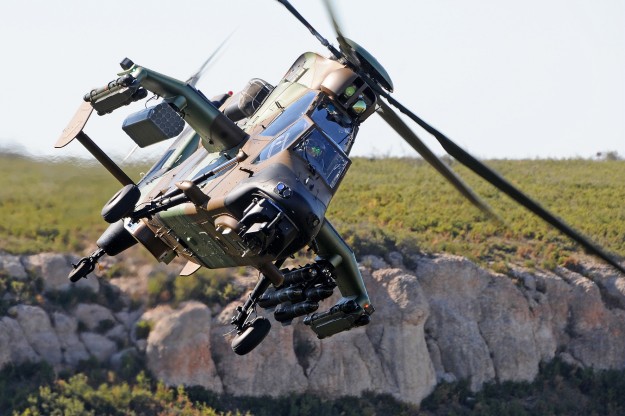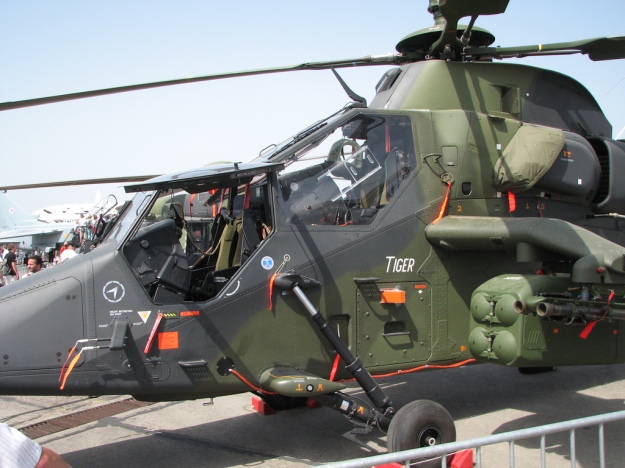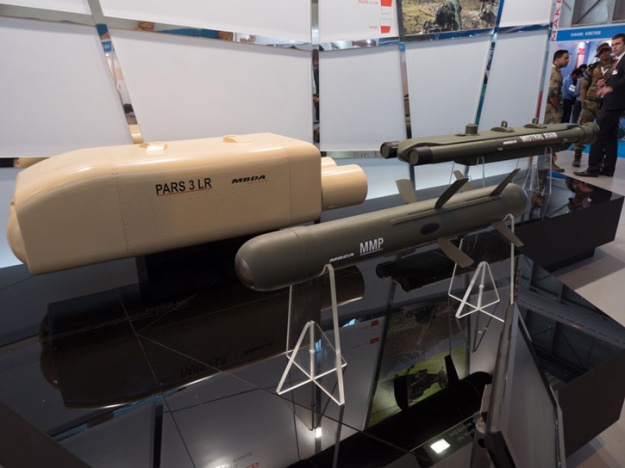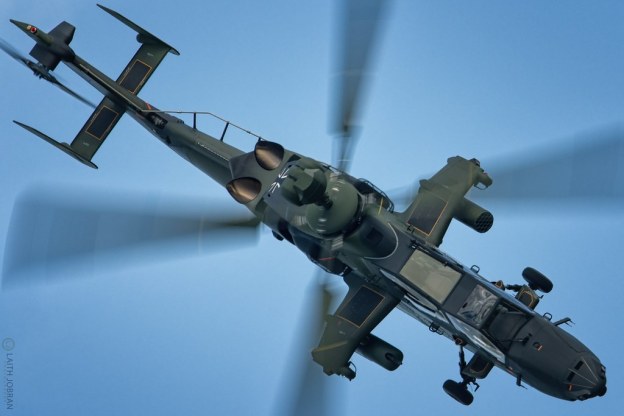The Airbus Helicopters Tiger, formerly known as the Eurocopter Tiger, is a four-bladed, twin-engined attack helicopter which first entered service in 2003. It is manufactured by Eurocopter (now Airbus Helicopters), the successor company to Aérospatiale’s and DASA’s respective helicopter divisions, which designate it as the EC665. In Germany it is known as the Tiger; in France and Spain it is called the Tigre.

The Tiger has the distinction of being the first all-composite helicopter developed in Europe; even the earliest models also incorporate other advanced features such as a glass cockpit, stealth technology and high agility to increase its survivability. Improved variants have since entered service, outfitted with more powerful engines and compatible with a wider range of weapons.


The Tiger has a tandem-seat ‘glass cockpit’ and is operated by a two-man crew; the pilot is placed in the forward position, with the gunner seated behind. Either of the crew members can manage the weapon systems or the primary flight controls, switching roles if necessitated; in addition to flying the aircraft, the Tiger’s pilot would typically be in control of the self-defence systems and communications, as well as some secondary weapons functions. While some of the weapons use dedicated control interfaces, such as the anti-tank Trigat missile, air-to-air weapons can be managed via controls on both sets of collective and cyclic sticks.
TopOwl® helmet-mounted sight and display

VISION
TopOwl provides the pilot with optimum vision of the environment featuring unique visor-projected intensified night vision which is extremely comfortable to use.
MISSION
To accomplish the mission, TopOwl can display before the pilot’s eyes images from any sensor located on the aircraft such as an FLIR HD. The high accuracy head tracking system is able to slave any weapon.
COMFORT
TopOwl provides the pilot with the best comfort, reducing pilot fatigue and improving performance over long and iterative missions.
TopOwl® has been chosen by 16 countries for their army, navy and/or air force attack and transport helicopters.
In full-rate production, TopOwl is operational on 5 major helicopter programmes: Tiger, NH90, Cobra AH-1Z, Huey UH-1Y and Rooivalk; T129 is in progress.
Main characteristics:
- Binocular 40° field-of-view
- Visor projection
- Modular Integrated Image Intensifier
- FLIR
- Compatible with full weapon suite: Guns, Rockets, Missiles
- Headborne weight < 2.2 kg
- Customized helmet liner to pilot head
- Integrated Display Capabilities:
– Stroke symbology
– Raster video image (FLIR)
– Image intensified secure
Source thalesgroup.com
 Canal THEATRUM BELLI YouTube
Canal THEATRUM BELLI YouTube Canal THEATRUM BELLI YouTube
Canal THEATRUM BELLI YouTube Canal THEATRUM BELLI YouTube
Canal THEATRUM BELLI YouTube
Cockpit
Image – Copyright © Flugzeuglexikon von Wolfgang Bredow – Berlin, Spandau
The protection systems employed on the Tiger includes stealth; aspects such as the visual, radar, infra-red and acoustic signatures have been minimised to better evade threats that may be present upon the battlefield. According to Andrew Warner, the Tiger’s survivability “relies on stealth and agility”. The fuselage is armoured and was developed to withstand small arms fire and 23 mm (0.91 in) cannon rounds. The helicopter has various radar/laser warning and missile-approach detection systems, including EADS’s AN/AAR-60 MILDS (Missile Launch Detection System), as well as flares and chaff dispensers.
EADS’s AN/AAR-60 MILDS (Missile Launch Detection System)
 EADS’s AN/AAR-60 MILDS (Missile Launch Detection System)
EADS’s AN/AAR-60 MILDS (Missile Launch Detection System)
Function
MILDS AN/AAR-60 is a passive, true imaging sensordevice optimised to detect the radiation signature in the UV solar blind spectral band that is emitted from an
approaching hostile missile exhaust plume. MILDS AN/AAR-60 detects incoming missile threats and indicates the direction of arrival at maximum warning time. The inherently high spatial resolution of MILDS combined with advanced temporal processing enables a
very high declaration rate while virtually eliminating false alarms. MILDS comprises four to six selfcontained detectors that provide high resolution and high sensitivity
without extra cooling. Each sensor provides fully processed signals. In addition, no central processing unit is required.
Integration
MILDS represents high quality and stability, combined with integrity and expandability of the entire system without causing any electromagnetic compatibility problems on board. MILDS offers easy installation due to extremely low weight and size but at the same time high comfort and fast processing of missile threats. High MTBF (Mean Time Between Failure) is possible because no moving parts are used in the MILDS systems sensors. Source hensoldt.net
Perhaps the most significant single avionics system fitted upon the Tiger is the mast-mounted Osiris sight/sensor; this incorporates optical TV and thermal cameras, a laser range finder/tracker/designator, and multiple gyroscopes for stabilisation.
Osiris sight/sensor
 Image @bredow-web.de – Copyright © Flugzeuglexikon von Wolfgang Bredow – Berlin, Spandau
Image @bredow-web.de – Copyright © Flugzeuglexikon von Wolfgang Bredow – Berlin, Spandau
The Osiris mast-mounted sight for a helicopter is produced by SAGEM (formerly SFIM Industries) and was designed for both HOT and TRIGAT missiles. The Osiris electro-optical acquisition system provides passive detection, recognition and identification of the target. The mast-mounted sight is equipped with an IR CCD thermal imager and a CCD television camera on a gyrostabilised platform. Source army-technology.com
A full range of sensors:
- visible and/or near infrared CCD TV camera
- passive 3-5 or 8-12um thermal imagers
- telemeter
- laser pointer
- laser designator or illuminator
- laser spot tracker
A range of optronic sights:
- Strix sight
- HAP EC665 Tiger helicopters
- HAD EC665 Tiger helicopters
- Strix HA sight (laser designator)
- ARH Tiger helicopters (army reconnaissance)
- Osiris sight
- multi-role UHT helicopters
- Viviane sights
- SA342 Gazelle helicopters (anti-tank)
Sagem also produces sights and gyrostabilized optronic pods, qualified on Eurocopter AS532 Cougar, EC725 Caracal, NH90, AS565 Panther and Denel AH-2 Rooivalk.
Source safran-electronics-defense.com

Osiris (CCD) – Visual
| General data: | |
|---|---|
| Type: Visual | Altitude Max: 0 m |
| Range Max: 55.6 km | Altitude Min: 0 m |
| Range Min: 0 km | Generation: LLTV, 3rd Generation (2000s/2010s) |
| Properties: Identification Friend or Foe (IFF) [Side Info], Classification [Class Info] / Brilliant Weapon [Automatic Target Aquisition], Continous Tracking Capability [Visual], LLTV / NVG / CCD (Night-Capable) / Searchlight [Visual Night-Capable] |
| Sensors / EW: |
|---|
| Osiris [CCD] – Visual Role: LLTV, Surveillance Camera Max Range: 55.6 km |
Osiris (FLIR) – Infrared
| General data: | |
|---|---|
| Type: Infrared | Altitude Max: 0 m |
| Range Max: 55.6 km | Altitude Min: 0 m |
| Range Min: 0 km | Generation: Infrared, 3rd Generation Imaging (2000s/2010s, Impr LANTIRN, Litening II/III, ATFLIR) |
| Properties: Identification Friend or Foe (IFF) [Side Info], Classification [Class Info] / Brilliant Weapon [Automatic Target Aquisition], Continous Tracking Capability [Visual], LLTV / NVG / CCD (Night-Capable) / Searchlight [Visual Night-Capable] |
| Sensors / EW: |
|---|
| Osiris [FLIR] – Infrared Role: Infrared, Surveillance FLIR Max Range: 55.6 km |
Osiris Laser Designator
| General data: | |
|---|---|
| Type: Laser Designator | Altitude Max: 0 m |
| Range Max: 27.8 km | Altitude Min: 0 m |
| Range Min: 0 km | Generation: Not Applicable (N/A) |
| Sensors / EW: |
|---|
| Osiris [Laser Designator] – Laser Designator Role: Laser Target Designator & Ranger (LTD/R) Max Range: 27.8 km |
STRIX turret-mounted, gyro-stabilised observation and sighting systems

The Strix is a roof-mounted sight designed for the Tiger attack helicopter. It includes IR and CCD-TV cameras, Laser range finder, and direct optics sight. Source deagel.com
Strix CCD – Visual
| General data: | |
|---|---|
| Type: Visual | Altitude Max: 0 m |
| Range Max: 55.6 km | Altitude Min: 0 m |
| Range Min: 0 km | Generation: LLTV, 3rd Generation (2000s/2010s) |
| Properties: Identification Friend or Foe (IFF) [Side Info], Classification [Class Info] / Brilliant Weapon [Automatic Target Aquisition], Continous Tracking Capability [Visual], LLTV / NVG / CCD (Night-Capable) / Searchlight [Visual Night-Capable] |
| Sensors / EW: |
|---|
| Strix [CCD] – Visual Role: LLTV, Surveillance Camera Max Range: 55.6 km |
Strix FLIR
| General data: | |
|---|---|
| Type: Infrared | Altitude Max: 0 m |
| Range Max: 55.6 km | Altitude Min: 0 m |
| Range Min: 0 km | Generation: Infrared, 3rd Generation Imaging (2000s/2010s, Impr LANTIRN, Litening II/III, ATFLIR) |
| Properties: Identification Friend or Foe (IFF) [Side Info], Classification [Class Info] / Brilliant Weapon [Automatic Target Aquisition], Continous Tracking Capability [Visual], LLTV / NVG / CCD (Night-Capable) / Searchlight [Visual Night-Capable] |
| Sensors / EW: |
|---|
| Strix [FLIR] – Infrared Role: Infrared, Surveillance FLIR Max Range: 55.6 km |
Strix Laser Rangefinder
| General data: | |
|---|---|
| Type: Laser Rangefinder | Altitude Max: 0 m |
| Range Max: 7.4 km | Altitude Min: 0 m |
| Range Min: 0 km | Generation: Not Applicable (N/A) |
| Sensors / EW: |
|---|
| Strix [Laser Rangefinder] – Laser Rangefinder Role: Laser Rangefinder Max Range: 7.4 km |
France to upgrade Tiger HAD to Mark II version
GRAM-S MILITARY GPS RECEIVER

GRAM-S SEM-E architecture 24 channel continuous tracking on L1 & L2 frequency; C/A-, P-, and Y-Code. Designed in accordance with the GPS “Receiver Application Module Guidelines” (GRAM-S). PPS operation handled by US JPO approved Selective Availability AntiSpoofing Module (SAASM). Able to operate either as a stand-alone or aided receiver for better A-J performances. Roadmaps include GPS M code and Galileo PRS.
Anti-Jam Thales patented Anti-Jam non-linear measurement processing and hybridisation techniques provide additional Anti-Jam benefits, that surpass conventional tight or ultra-tight coupling. Fast Y code acquisition is achieved in the most severe jamming environment, using multi-correlation algorithms that can perform up to 2,000,000 signal detection each second using more than 12,000 Time/Frequency correlators. Full details: Here
AGM-114 Hellfire 2

AGM-114K Hellfire II
- Target: All armored threats
- Range: 8,000 m (8,749 yd)
- Guidance:
- Semi-active laser homing with electro-optical countermeasures hardening
- Digital autopilot improvements allow target reacquisition after lost laser lock
- New electronic SAD
- Warhead: 9 kg (20 lb) tandem shaped charge HEAT
- Length: 163 cm (64 in)
- Weight: 45.4 kg (100 lb)
- Essentially the proposed AGM-114J w/ SAD
AGM-114R Hellfire II (Hellfire Romeo)
- Target: All Target Types
- Range: 8,000 m (8,749 yd)
- Guidance:
- Semi-active laser homing
- Warhead: Multi-function warhead
- Weight: 50 kg (110 lb)
- Speed: Mach 1.3
France to launch mid-life upgrade for Tiger attack helicopter to Mk 3: Here
Excerpt
France is now prepared to set specifications, draw up contracts and identify risks for the midlife upgrade of its Tiger attack helicopter, following an investment meeting held May 2 by Armed Forces Minister Florence Parly.
Osiris performs as the main sensor for target observation and acquisition, providing firing and targeting data via the weapons computer; Osiris also enables entirely passive target acquisition to be undertaken and was developed to maximise the capabilities of the Trigat anti-tank missile developed in parallel to the Tiger itself. An alternative optical system to Osiris is mounted on the aircraft’s roof upon some variants.

France Orders More Tigers, Plans $41.6B Budget Increase: Here
Airbus declares that all Tiger combat helicopters are unsafe: Here
Excerpt
After the crash of a Tiger combat helicopter of the Bundeswehr in Mali on July 26, the manufacturer company Airbus Helicopters issued a safety warning to all users of this helicopter type, which was supplemented on (today) Thursday again. In this, as a precaution, all variants of the helicopter used by the French, Spanish and Australian armed forces are declared insecure.
Operators: Here
Specifications (Tiger HAP)

Data from Wilson, McGowen
General characteristics
- Crew:Two: pilot and weapon systems officer
- Length:08 m fuselage (46 ft 2 in)
- Rotor diameter:00 m (42 ft 8 in)
- Height:83 m (12 ft 7 in)
- Disc area:133 m² (1,430 ft²)
- Empty weight:3,060 kg (6,750 lb)
- Loaded weight:5,090 kg (11,311 lb)
- takeoff weight:6,000 kg (13,000 lb))
- Powerplant:2 × MTU Turbomeca Rolls-Royce MTR390 turboshafts, 958 kW (1.303 shp) each
- Internal fuel capacity:1,080 kg (2,380 lb)
2 x MTU Turbomeca Rolls-Royce MTR390E turboshafts
The MTR390 covers the 1,250 to 1,450 shp range. It is designed for six-to-seven ton military rotorcraft and is installed in the Airbus Helicopters Tiger attack helicopter. The development of the MTR390 is the result of a partnership between MTU Aero Engines, Rolls-Royce, ITP and Safran Helicopter Engines. Production began in 2000. Two versions are in service: the 2C fitted to the Tiger HAP, ARH and UHT variants; and the E, intended for the Tiger HAD. The in-service fleet has collectively logged over 130,000 operating hours.
With unrivaled power-to-weight and dimensions-to-power ratios, the MTR390 is designed for performance. The E model offers a maximum take-off power of 1,467 shp and, using the One Engine Inoperative (OEI) rating, is capable of 1,773 shp.
The MTR390 was designed to perform in the harshest of environments and to offer simple maintenance. It features three main modules: a compressor with two centrifugal stages (to cope with the most difficult conditions, including sandy environments); a single-stage high pressure turbine equipped with cooled single-crystal vanes; and a particularly robust two-stage power turbine. Servicing is based on the concept of on-condition maintenance and requires a simple set of standard tools.
The MTR390 is equipped with dual-channel Full Authority Digital Engine Control (FADEC) which, through allowing engine performance and usage monitoring, lightens air and ground crew workload while maximizing performance.
 MTU Turbomeca Rolls-Royce MTR390 turboshafts, 958 kW (1.303 shp) each
MTU Turbomeca Rolls-Royce MTR390 turboshafts, 958 kW (1.303 shp) each
Source safran-helicopter-engines.com
Performance
- Maximum speed:290 km/h with mast, 315 km/h without mast (157 knots, 181 mph with mast, 170 knots or 196 mph without mast)
- Range:800 km (430 nm, 500 mi) combat (with external tanks in the inboard stations: 1,300km)
- Service ceiling:4,000 m (13,000 ft)
- Rate of climb:7 m/s (2,105 ft/min)
- Power/mass:23 hp/lb (0.38 kW/kg)
Armament
- Guns:
- 1× 30 mm (1.18 in) GIAT 30 cannon in chain turret, with up to 450 rounds.
GIAT 30 mm cannon in chain turret

30 mm (1.18 in) GIAT 30 M781 cannon in chain turret muzzle velocity is 810 m/s (2. 657 ft/s) with a rate of fire of 750 rounds per minute.
On each of its two inner hardpoints and two outer hardpoints the Eurocopter Tiger can carry a combination of the following weapons:
- Inner hardpoints:
- 1x 20 mm (0.787 in) autocannon pods, or
- 22x 68 mm (2.68 in) SNEB unguided rockets in a pod, or
- 19x 70 mm (2.75 in) Hydra 70 unguided rockets in a pod or
- 4x AGM-114 Hellfire missiles (Australia/France) or
- 4x Spike-ER missiles (Spain) or
- 4x PARS 3 LR missiles (Germany) or
- 4x HOT3 missiles (Germany)
- Outer hardpoints:
Laser-guided Rocket For the French Army: Details
TDA has developed and conducted live firings with a new-generation rocket launcher for the latest generations of combat aircraft such as the Rafale from DASSAULT AVIATION.
The TELSON 12 JF (Jet Fighter) rocket-launcher is designed for induction-activated rockets and is ideally suited to close air support missions.
The future Induction Laser Guided Rocket (ILGR) will provide a precision strike capability out to 10,000 metres, beyond the range of the most common MANPADS threats. Source tda-armements.com
MBDA and Roketsan will integrate Cirit rockets to the Tiger UHT helicopters: Details

2.75” Laser Guided Missile CİRİT
 Image @roketsan.com.tr
Image @roketsan.com.tr
Properties of the Product
CİRİT, is a missile with the longest range in its class which provides a superior precision against light, armored/unarmored and stationary/mobile targets as well as being a cost effective solution.
Basic Specifications
- The 2.75″ Missile with the Longest Range
- Insensitive Munitions (Level V)
- Multi Purpose (Armor Piercing, Anti Personnel and Incendiary) Warhead
- Integration to Various Platforms (Helicopter, UAV, Land Vehicle, Stationary Platform, Light Assault Aircraft, Naval Platform)
- Standard Mode and Smart Mode Pod Integration
- Not a Guidance Kit, New Generation All-Up Round Missile System
- Composite Propellent Technology with Reduced Smoke
In the Inventory of Turkish Armed Forces
Product Description
2.75” Laser Guided Missile CİRİT was designed for the purpose of filling the gap between cheap, unguided rockets with low precision and the high cost, guided anti-tank missiles.
CİRİT can be fired from standard CİRİT POD developed by Roketsan and as well as from Smart Pod. Smart Pod increases the capability envelope of CİRİT missile for inventory information exchange through the platform it possess prior to launch.
CİRİT is stored in the canister which facilities loading and unloading.
 Image @roketsan.com.tr
Image @roketsan.com.tr
CİRİT, by means of its aerodynamic shape and composite solid propellant rocket motor, has the longest range in its class, 8 km, as compared to classic 2.75” unguided rockets.
Moreover, CİRİT missile offers options, such as multipurpose warhead (Armor Piercing Anti-personnel and Incendiary) as well as High Explosive warhead.
CİRİT system defined as the official missile system of National Attack Helicopter (T – 129) under development and can be also integrated to various platforms (Helicopter, UAV, Land Vehicle, Light Assault Aircraft, Naval Platform).
 Cirit canister
Cirit canister
| Diameter | 2.75″ (70 mm) |
| Maximum Range | 8 km |
| Minimum Range | 1,5 km |
| Weight | 15 kg (Without tube complete) |
| Propellant Type | HTPB Based, Smokeless, Composite Solid Propellant |
| Warhead Type | Multi Purpose Warhead, Armor Piercing, Personnel, Incendiary |
| Warhead Type | High Explosive Warhead |
| Guidance | Mid – Phase Guidance with MEMS – AÖB |
| Guidance | Terminal Guidance with Semi-Active Laser Seeker |
| Target Types | Light Armored / Unarmored Vehicles, Stationary and Moving Targets, Bunkers |
| Platforms | Helicopters (AH – 1W, T – 129 ATAK etc.), UAV’s, Land Vehicles, Light Assault Aircraft, Naval Platforms and Stationary Platforms |
Data roketsan.com.tr
20 mm (0.787 in) autocannon pod & FIM-92 Stinger air-to-air missiles
 20 mm (0.787 in) autocannon pods and FIM-92 Stinger air-to-air missiles
20 mm (0.787 in) autocannon pods and FIM-92 Stinger air-to-air missiles
AGM-114 Hellfire missiles
AGM-114 Hellfire missiles (right) air-to-ground missile developed primarily for the anti-armour. Each Hellfire weighs 45.4kg-49kg including an 8kg-9kg multipurpose warhead. It has 8km (LOAL, high trajectory), 7.1km (LOAL, low / direct trajectory) and 11km (UAS: LOAL, high trajectory) range depending on the trajectory.
Spike-ER missiles and unguided rockets
Spike-ER missiles and unguided rockets in a pod Rafael, based in Haifa, Israel, manufactures the Spike family of anti-armour weapons. The weapons are lightweight fire-and-forget anti-tank missiles and use electro-optical and fibre-optic technologies (formerly known as NTD Dandy) with a range of 8,000m
PARS 3 LR missiles (TRIGAT LR)
 PARS 3 LR missiles (TRIGAT LR) The operating range is given as 500m to 5,000m, but the range is extendible to 7,000m. Salvo firing provides a firing rate of up to four missiles in eight seconds.
PARS 3 LR missiles (TRIGAT LR) The operating range is given as 500m to 5,000m, but the range is extendible to 7,000m. Salvo firing provides a firing rate of up to four missiles in eight seconds.
PARS 3 LR is a high precision fire-and-forget weapon system for the engagement of mobile and stationary targets equipped with the latest generation of armour protection as well as buildings, bunkers and other high-value targets.
The fire-and-forget capability of PARS 3 LR enables the platform system to leave its position immediately after firing the missile. In this way, platform and crew are exposed to the enemy’s reconnaissance and counter-action for a minimal amount of time. The precision and effectiveness of the missile is ensured over the entire firing range.
PARS 3 LR
HIGH PRECISON FIRE – AND – FORGET
WEAPON SYSTEM WITH MULTIROLE CAPABILITY
- Fire-and-forget missile system
- High precision and penetration power
- Salvo-firing capability
- Quick reaction time
- Engagement of multiple targets
Source mbda-systems.com

TRIGAT LR is a third-generation anti-tank missile
TRIGAT LR is a third-generation anti-tank missile for long-range applications. The missile is also known as PARS-3 (panzerabwehr rakensystem 3) in Germany and AC 3G (antichar de 3e generation) in France. The missile is integrated on the Eurocopter Tiger helicopter developed for the French and German armies.
TRIGAT is a European programme involving France, Germany and the United Kingdom.
Both long-range and medium-range TRIGAT use thrust vector control for high agility in flight and precision targeting. The operating range is given as 500m to 5,000m, but the range is extendible to 7,000m. Salvo firing provides a firing rate of up to four missiles in eight seconds.
TRIGAT LR can be applied in direct attack or terminal dive modes. The system is equipped with a tandem shaped charge warhead for high lethality against modern reactive armour. A proximity charge detonates at an optimum distance from the target.
The dimensions of the TRIGAT LR missile are approximately length 1,500cm x body diameter 15cm. The missile weighs 49kg. Source army-technology.com
HOT 3 is a long-range anti-tank weapon system
HOT 3 is a long-range anti-tank weapon system tube-launched, wire-guided missile has a 6.5kg tandem charge warhead which is effective against explosive reactive armour (ERA), penetrating up to 1,300mm range of the missile is from 75m to 4,000m
| General data: | |
|---|---|
| Type: Guided Weapon | Weight: 34 kg |
| Length: 1.3 m | Span: 0.31 m |
| Diameter: 0.15 | Generation: None |
| Properties: Terrain Following, Level Cruise Flight |
| Targets: Surface Vessel, Land Structure – Soft, Land Structure – Hardened, Mobile Target – Soft, Mobile Target – Hardened |
| Weapons: |
|---|
| HOT 3 – (1994) Guided Weapon Surface Max: 5.6 km. Land Max: 5.6 km. |
19 tubes (FZ225)

FZ225 is a lightweight composite material high-drag, straight cylindrical 19-tube reusable launcher designed for helicopter use. The FZ225 is equipped with removable universal dual purpose FZ125 detent mechanism enabling to fire FFAR and WA rockets.
It can be fitted with an optional removable rear fairing.
Mechanical characteristics
The FZ225 rocket launcher system includes a nineteen (19) tube rocket composite central section with equipped with a Launcher Interface Unit (LIU).
- Outer diameter : 402 mm
- Overall length : 1668 mm
- Total mass (empty) : 45 kg
Mechanical interface
- 14” NATO standard suspension lugs
Performances
- Firing mode : ripple / single
- Intervallometry : 80 ms (minimum)
- Dual purpose : designed for firing both types of FZ 2.75″ FZ FFAR and WA rocket motors
- Rocket warheads : designed for firing all types of conventional 2.75″ FZ rocket warheads equipped with a remote set fuze
7 tubes (FZ233)

FZ233 is a lightweight composite material high-drag, straight cylindrical 7-tube reusable launcher designed for helicopter use. The FZ233 is equipped with removable universal dual purpose FZ125 detent mechanism enabling to fire FFAR and WA rockets.
The design of the FZ233 is identical to that of the rocket launcher FZ220, but equipped with a LIU interface (Launcher Interface Unit).
It can be fitted with an optional removable rear fairing.
Mechanical characteristics
The FZ233 rocket launcher system includes a seven (7) tube rocket composite central section.
- Height : 288.3 mm
- Width : 243.4 mm
- Overall length : 1653.5 mm
- Total mass (empty) : 26kg
Mechanical interface
- 14” NATO standard suspension lugs
Performances
- Firing mode : ripple / single
- Intervallometry : 80 ms (minimum)
- Dual purpose : designed for firing both types of FZ 2.75″ FZ FFAR and WA rocket motors
- Rocket warheads : designed for firing all types of conventional 2.75″ FZ rocket warheads and are equipped with a remote set fuze
Source fz.be
Estimated cost: USD 45 million (wiki)
Source: miltechmag.com, deagel.com, army-technology.com, wikiwand
Images are from public domain unless otherwise stated
Main image Laith Jobran @flickr
Updated Nov, 2020
























































 Saab 2000 cockpit
Saab 2000 cockpit









 Allison AE 2100A turboprop, 3,096 kW (4,152 shp) each
Allison AE 2100A turboprop, 3,096 kW (4,152 shp) each